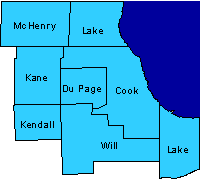|
Tornadoes are one of nature's most awesome forces. Throughout history, many tornadoes have ravaged the Chicago metro area, and despite popular myth, several have struck within the city limits of Chicago. The following is a study of significant tornadoes that occurred in the Chicago area between 1855 and 2008. For the purpose of this study, a significant tornado is defined as being rated F2/EF2 or greater, or any tornado that has caused fatalities or injured at least 10 people. Weaker tornadoes (F0 and F1) are more common but not as well documented as strong (F2 and F3) and violent (F4 and F5) tornadoes, especially before about 1950. The significant tornadoes account for most of the deaths, injuries, and property damage from tornadoes. The Fujita scale, or F scale, estimated wind speeds based on damage intensity, where F0=40-72 mph, F1=73-112 mph, F2=113-157 mph, F3=158-206 mph, F4=207-260 mph, and F5=261-318 mph. The F scale was determined by conducting ground and air surveys of the damage path. The F scale was developed in the 1970s and was later applied to historical data, based on written accounts and photographs of tornado damage. Therefore the F scale ratings are subjective and may not accurately reflect the wind produced by the tornado. The F scale was replaced by a new Enhanced F scale in February, 2007. Estimated wind intensity with the scale was adjusted, but the historical database will not change. EF0=65 to 85 mph, EF1=86-110 mph, EF2=111-135 mph, EF3=136-165 mph, EF4=166-200 mph, EF5=>200 mph. To learn more about the enhanced F scale, go to http://www.spc.noaa.gov/efscale/. Sources for the data in the study include StormData, the Storm Predication Center, Significant Tornadoes 1680-1991 written by Tom Grazulis and local data. For the purpose of this study, the Chicago area is defined as McHenry, Lake, Kane, DuPage, Cook, Kendall, Will, and Lake (IN) counties. 
F-Scale Distribution of Significant Tornadoes Monthly Distribution of Significant Tornadoes Diurnal Distribution of Significant Tornadoes For the purpose of this study, the hour indicated is the hour in which the tornado began. For example, if a tornado began at 155 PM and ended at 205 PM. It will be considered as occurring in the 100 PM hour. Time is local time. Most tornadoes occur in the afternoon and evening hours, with a strong peak showing up during the 5:00 PM hour. Tornadoes are extremely rare in the early morning hours. Solar radiation heats the ground, which heats the lower atmosphere. The atmosphere becomes most unstable during the warmest time of day, which is typically in middle to late afternoon. The atmosphere gradually cools and stabilizes after dark, diminishing the threat of severe storms and tornadoes. But tornadoes can occur anytime of day or night. Decade Distribution of Significant Tornadoes Deaths and Injuries from Tornadoes
Multiple Significant Tornado Days When conditions are favorable for the formation of significant tornadoes, sometimes several significant tornadoes occur in the same area on the same day. Since 1950, when more reliable record keeping began, there have been ten days that produced multiple significant tornadoes in the Chicago area. The worst was April 21, 1967, when six significant tornadoes occurred, including three violent F4 tornadoes. There was a total of ten tornadoes including four F1s. The most recent event was June 7, 2008 when four significant tornadoes occurred. Before 1950 there were five multiple tornado days documented. There is probably not enough data to draw any conclusions. There have been two in March, four in April, three in May, one in June, one in July, one in August, one in September, none in October, and two in November.
To look at the frequency of significant tornadoes by county, one must first level the playing field since counties vary greatly in size. Tornado frequency was calculated per hundred square miles. Doing this, Lake County Indiana tops the list with, followed by DuPage. Will County, popularly known by some as the Chicago area’s tornado alley, surprisingly only ranks sixth out of the eight counties in the study. Lake County Indiana also leads, along with Cook, with four violent (F4 or greater) tornadoes.
Other Significant Tornadoes Near the Chicago Metro Area Rockford - On September 14, 1928 an F4 tornado had a 26 mile path from 8 miles south southwest of Rockford through the southeast side of the city and ended in Boone County. 14 people were killed, 100 injured, and $1.2 million in damage was done. This was part of a large outbreak. There were several other tornadoes in southern Wisconsin. Kankakee - In addition to the 1948 F4 tornado which started in eastern Kankakee County and passed through Lake County Indiana (which is already documented in the Chicago statistics) there was an F4 tornado April 17, 1963. It had a 70 mile path from 3 miles northwest of Essex to just west of Medaryville, IN. It affected Kankakee, Newton, Jasper, and Pulaski Counties. There was near F5 damage with several houses swept away in Kankakee County and again in Jasper County. The worst damage was in the Bradley-Bourbonnais area north of Kankakee. 1 person was killed and 70 were injured. One of the biggest tornadoes of the April 3, 1974 super-outbreak began in rural Benton County, but the most intense damage was at Monticello in White County where the damage path was 1/2 mile wide. This F4 tornado had a 121 mile path but may have been a family of 3 tornadoes.
Trends Since 1950
Conclusions
Detailed Information for each of the 92 Tornadoes (PDF Format)
|